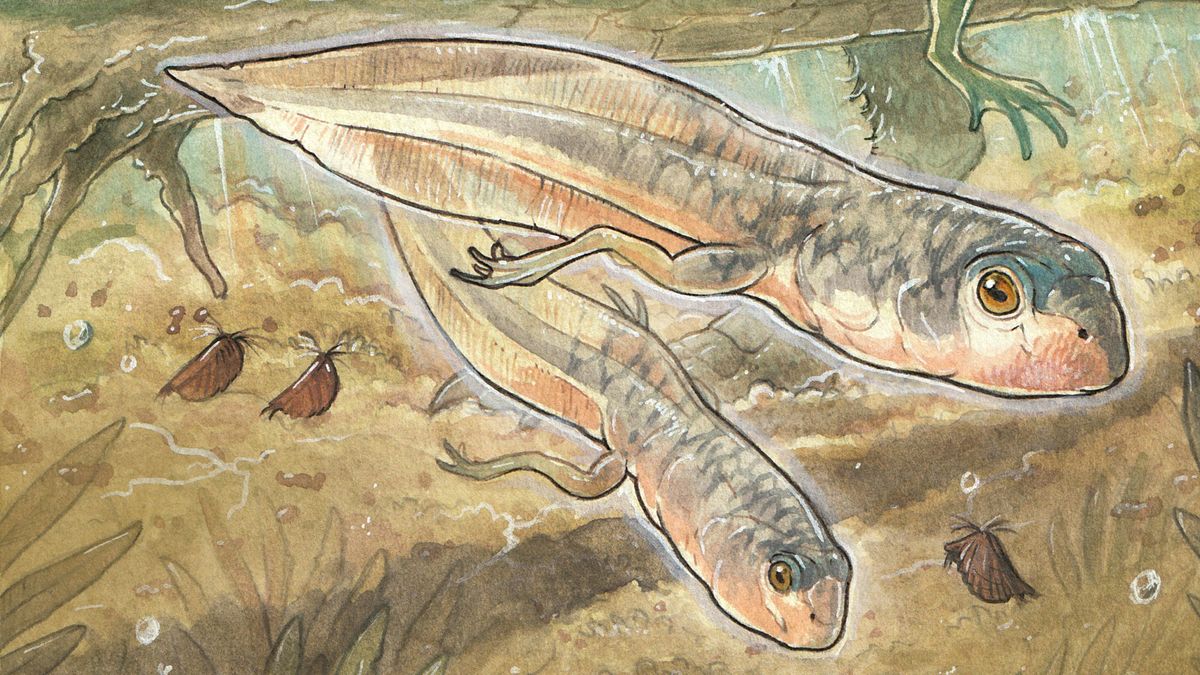Paleontologists exploring Argentina have unearthed the oldest tadpole fossil on record. This fossil, dating back approximately 161 million years to the Jurassic period surpasses the previous record-holder by roughly 20 million years.

Also Read: Dinosaur Fossils News: First-Ever Discovery of Dinosaur Remains in Hong Kong
Discovered in the La Matilde Formation of Patagonia, Argentina, paleontologists were initially searching for dinosaur fossils when they came across this oldest tadpole fossil.
The fossil belonged to the extinct frog species Notobatrachus degiustoi. Fossils from this period contribute to understanding frog evolution.
The oldest tadpole fossil finally links juvenile and adult stages in frog evolution, giving scientists evidence of the tadpole stage among early frogs.
Unlike most tadpoles, which rarely fossilize due to their soft, cartilaginous bodies, this oldest tadpole fossil retained soft tissue imprints, including eyeballs, gills and vertebrae.
This level of preservation is exceptionally rare and allowed scientists a detailed view of an ancient frog’s juvenile stage.
It is estimated to be 161 million years old, this fossil dates back to the Middle Jurassic era, while the previous oldest tadpole fossil was from the early Cretaceous period, roughly 145–100 million years ago.
Mariana Chuliver, a biologist at Maimónides University and lead author on the study notes that the oldest tadpole fossil provides evidence against the theory that early frogs lacked a tadpole stage.
With frog fossils dating to the late Triassic period, around 217 million years ago, this new discovery supports the idea that the tadpole stage evolved earlier than previously believed.
Measuring about 6 inches long, this oldest tadpole fossil was large, rivaling the size of some adult frogs today. Its tail alone spanned 3 inches.
The fossil’s skeletal features particularly its partially ossified vertebrae, helped researchers identify the species and align it with its adult form, Notobatrachus degiustoi.
Not only was the tadpole large, but the adult N. degiustoi also reached dimensions compared to most modern frogs.
This size consistency between the tadpole and adult forms is rare among today’s frog species. Scientists speculate that the ample resources in Jurassic ponds allowed for development, enabling both juvenile and adult stages to reach larger sizes.
This tadpole reached a length of six inches, comparable to the size of an adult frog in its species. Most tadpoles are smaller than their adult counterparts, but this Notobatrachus tadpole’s size rivals that of some adult frogs, which is rare in the natural world.
This fossil displays anatomical details such as soft tissues and cartilage, which are rarely preserved in fossils. These details help paleontologists piece together how this tadpole looked and functioned in its natural habitat.
The fossil shows a partially developed tadpole including tiny forelimbs, hind limbs and a bony vertebral column.
Also Read: Scientists Use Paleo-Inspired Robotics to Resurrect Extinct Animals
The process of metamorphosis is a complex transformation, where a tadpole with a long tail and oversized head changes into an adult frog with limbs and a distinct frog shape.
Understanding the origins of this transformation in amphibians has puzzled researchers. The tadpole fossil offers evidence that amphibians have undergone metamorphosis since at least the Jurassic Period.
It provides insight into how this unique life cycle may have evolved. The discovery challenges previous theories that ancient frogs may have bypassed the tadpole stage.
Evidence from this fossil suggests that tadpoles were likely a consistent part of the frog life cycle even in ancient times.
The fossil displays a specialized gill system used for filter feeding, indicating that this feeding adaptation has been present since the beginning of the frog lineage.
Today, over 6,000 species of tadpoles use similar filter-feeding mechanisms. Researchers speculate that the large size of this tadpole may have resulted from an abundant food supply and a lack of competitors in the seasonal ponds of Jurassic Patagonia.
This lack of competition allowed the tadpoles to grow indefinitely. The tadpole’s anatomy and habitat suggest that ancient frog-like amphibians thrived in nutrient-rich, seasonal ponds, where they evolved distinct characteristics suited to these environments.
The oldest tadpole fossil was preserved in an advanced developmental stage with ossified vertebrae, making fossilization more feasible. This factor allowed the juvenile’s vertebrae to leave recognizable marks.
This Jurassic tadpole shared several structural traits with modern tadpoles including a similar size and body shape. This resemblance suggests that the evolution of the tadpole stage and its associated features occurred much earlier than previously thought.
Scientists identified remnants of a gill scaffold, pointing to a filter-feeding mechanism similar to that used by today’s tadpoles. This system allows tadpoles to filter and consume plankton, algae and detritus.
During the Jurassic period, rich aquatic resources may have allowed tadpoles like N. degiustoi to develop for extended periods. This environment facilitated an adaptation that supported a unique survival strategy.
Also Read: NASA Crew-8 Astronaut Released from Hospital After Return From ISS





















